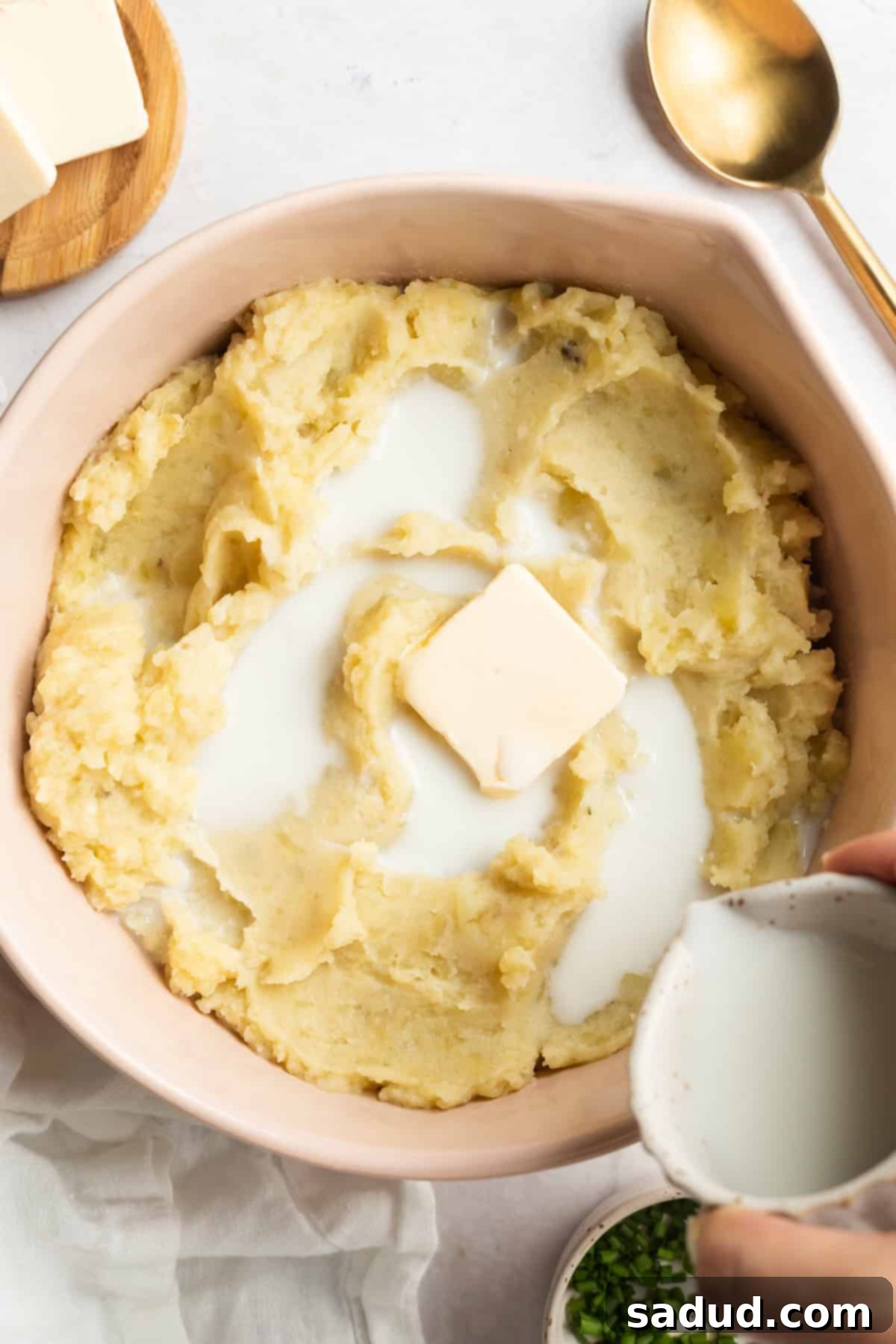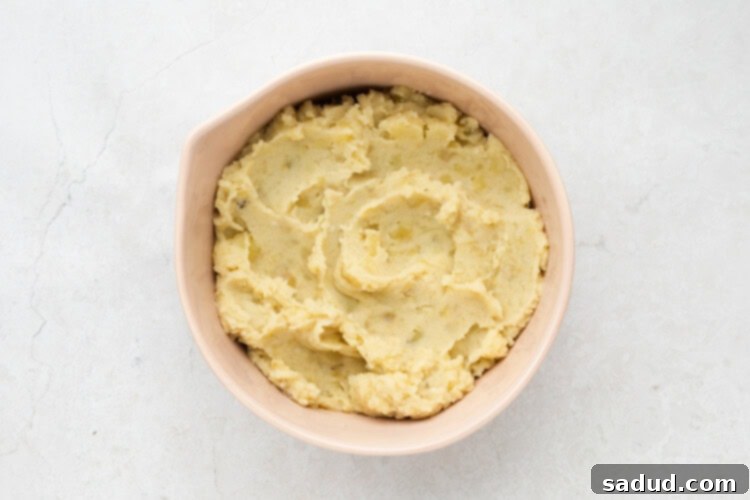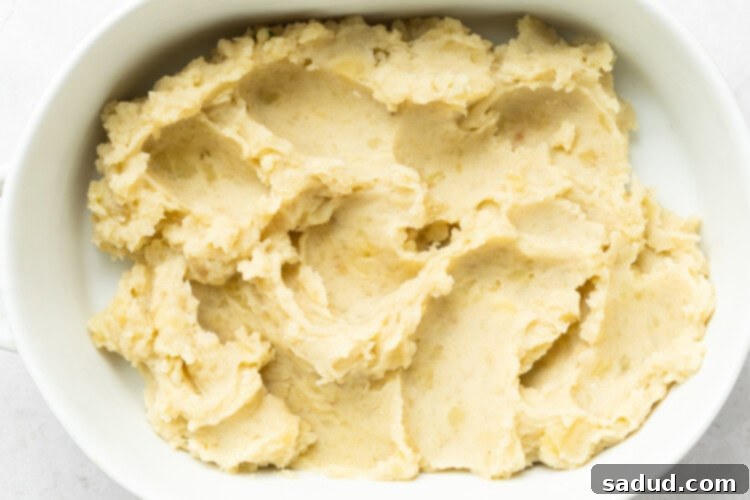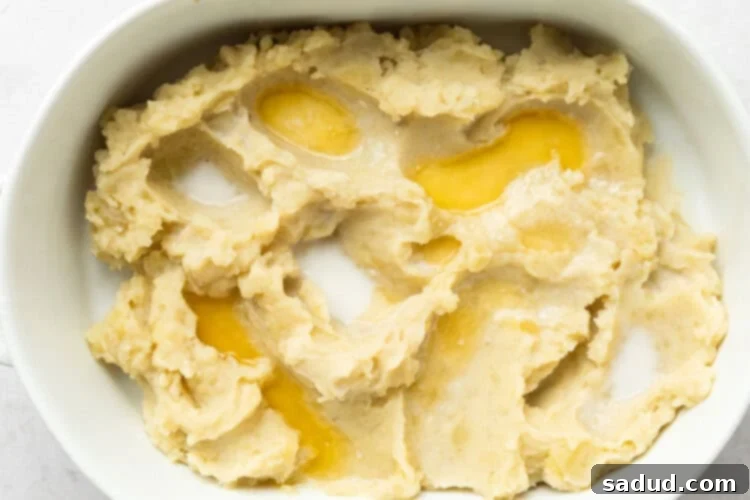Mastering Leftovers: The Ultimate Guide to Reheating Mashed Potatoes for Perfect Creaminess
Don’t let leftover mashed potatoes go to waste or turn into a dry, sad mess! This comprehensive guide provides the best, easiest, and most effective ways to bring your mashed potatoes back to life. Whether you’re meal-prepping for the week or simply savoring every last bit of a holiday feast, these methods promise perfectly smooth, hot, and incredibly creamy mashed potatoes that are arguably even better than the first time around. Say goodbye to dry, lumpy potatoes and hello to a luscious, comforting side dish, every single time.
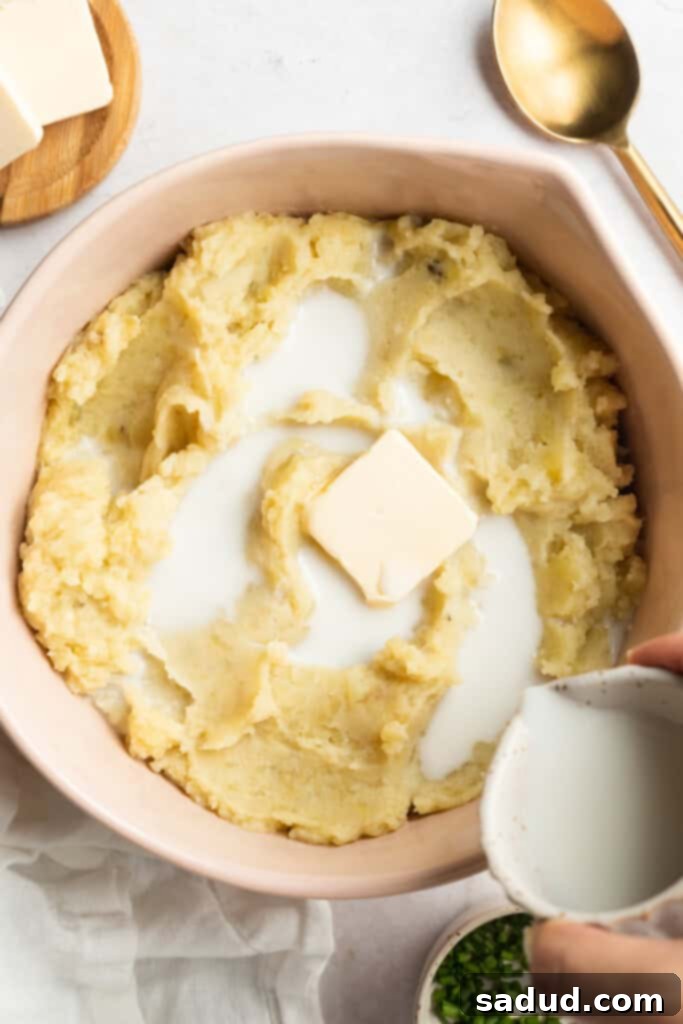
Why These Reheating Methods Are Game-Changers
Reheating mashed potatoes can often feel like a culinary challenge. Many people resign themselves to a dry, unappetizing result. However, with the right approach, your reheated mashed potatoes can be just as, if not more, delicious and creamy than when they were first made. Here’s what makes our methods truly stand out:
- Unparalleled Richness and Flavor: Each of our recommended methods thoughtfully incorporates additional milk and butter. This isn’t just a suggestion; it’s a secret weapon! As mashed potatoes sit, they tend to lose some of their original moisture and richness. By reintroducing these key ingredients, we don’t just restore them; we enhance their flavor profile, making them even more luxurious and delectable. You might just find yourself preferring these reheated potatoes!
- Moisture Locked In, Dryness Banished: The most common complaint about reheated mashed potatoes is their tendency to become dry and stiff. Our methods are specifically designed to combat this. We focus on gentle, consistent heating and crucially, re-emulsifying the potatoes with fresh dairy. This process ensures that moisture is not only added back but also effectively locked into the potatoes, resulting in an irresistibly soft, velvety, and creamy texture that melts in your mouth.
- Quick, Easy, and Hassle-Free: We understand that convenience is key, especially when dealing with leftovers. That’s why each of these reheating techniques is streamlined for efficiency. With just two simple steps involved in most cases, you can transform cold, dense mashed potatoes into a warm, fluffy side dish ready for your dinner table in mere minutes. No complicated procedures, no extensive clean-up—just delicious results with minimal effort.
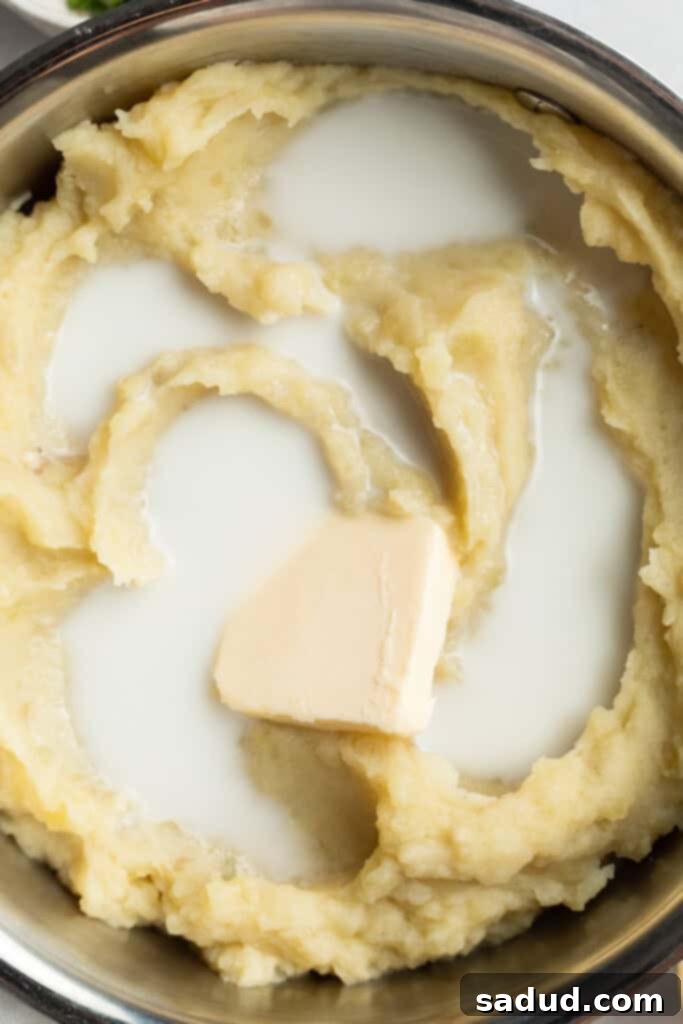
Demystifying Dry Mashed Potatoes: The Science Behind It
Before diving into the reheating methods, it’s helpful to understand why mashed potatoes often dry out. When potatoes cool, the starches within them undergo a process called retrogradation. Essentially, the starch molecules re-crystallize, pushing out the water they absorbed during cooking. This causes the potatoes to become stiff, dense, and yes, dry. Additionally, simply blasting them with high heat, especially in a microwave, can quickly evaporate any remaining moisture, exacerbating the problem. Our methods work by counteracting this starch retrogradation and replenishing lost moisture, ensuring a smooth and creamy outcome.
The Best Methods for Reheating Leftover Mashed Potatoes
Now, let’s explore the foolproof ways to reheat your mashed potatoes, ensuring they emerge perfectly smooth and delicious, ready to impress.
1. Reheating Mashed Potatoes in the Microwave: Quick and Convenient
The microwave is undoubtedly the fastest option, but it requires a specific technique to avoid rubbery, dry potatoes. Forget simply blasting them on high power; this method is all about gentle heat and moisture infusion.
- Step 1: Gentle Heat First. Transfer your cold mashed potatoes to a microwave-safe bowl. Crucially, heat your potatoes at half power (or 50% intensity) for 5-7 minutes, depending on the quantity. Heating at a lower power setting helps to warm the potatoes through without rapidly evaporating their internal moisture. You might need to stir them halfway through to ensure even heating. For larger portions, consider extending the time slightly.
- Step 2: Reintroduce Moisture and Creaminess. Once the potatoes are warm throughout, remove them from the microwave. Now, it’s time to bring them back to life. Add a tablespoon or two of milk (or cream for extra richness) and a knob of butter. Use a fork or a potato masher to thoroughly stir and beat these additions into the potatoes until they are smooth, creamy, and have achieved your desired consistency. Add more milk or butter, a tablespoon at a time, if they are still too thick or dry. The gentle stirring helps to break down any solidified starches and re-emulsify the fat and liquid, restoring that fresh texture.
This method is ideal for smaller portions and when you’re in a hurry, offering a remarkably fresh taste in minutes.
2. Reheating Mashed Potatoes in the Oven: The Hands-Off Approach
For those who prefer a more hands-off method, or are reheating a larger batch, the oven delivers beautifully consistent results. This technique uses gentle, even heat to warm the potatoes, preventing them from drying out.
- Step 1: Prepare for Baking. Preheat your oven to 350°F (175°C). Transfer your leftover mashed potatoes into an oven-safe baking dish. Spread them evenly in the dish.
- Step 2: Infuse and Cover. Drizzle about ½ cup of milk (or half-and-half) over the top of the potatoes, and dot them generously with 2-3 tablespoons of butter. Do not stir anything in at this stage; simply let the liquids and fat rest on top. Covering the dish tightly with aluminum foil is essential. The foil creates a steamy environment, trapping moisture and allowing the potatoes to rehydrate as they warm.
- Step 3: Bake to Perfection. Bake for approximately 25-30 minutes, or until the potatoes are thoroughly heated through and soft. The exact time will vary based on the amount of potatoes and the depth of your dish. Once warm, remove the foil, give the potatoes a good stir to incorporate the melted butter and milk, and you’ll be amazed at their fresh, creamy texture and delicious flavor.
This method is fantastic for holiday leftovers or larger family meals, providing uniform heat and minimal active involvement.
3. Reheating Mashed Potatoes on the Stove: Creamy, Restaurant-Quality Results
The stovetop method offers excellent control over the consistency and temperature, making it a favorite for achieving that perfectly creamy, restaurant-quality texture. It requires a bit more attention but yields fantastic results.
- Step 1: Combine and Heat Gently. Place your leftover mashed potatoes in a large saucepan or pot over low heat. Add about ½ cup of milk and 1 tablespoon of butter (or more, to taste) to the pot with the potatoes. The low heat is crucial here; it prevents the potatoes from sticking to the bottom and scorching.
- Step 2: Stir Continuously for Smoothness. Begin warming the potatoes, stirring them frequently, at least every minute. The goal is to slowly melt the butter and incorporate the milk, gently rehydrating the potatoes. As they warm, they will loosen up and become smooth. Continue stirring until the mashed potatoes are hot throughout and have reached your desired creamy consistency. This process usually takes about 8-10 minutes.
The stovetop method allows you to adjust the creaminess as you go, making it ideal for those who like to have precise control over their cooking.
Essential Tips for Reheating Mashed Potatoes Like a Pro
To ensure your reheated mashed potatoes are always a success, keep these expert tips in mind:
- Never Skimp on Moisture: This is arguably the most critical tip. As discussed, mashed potatoes lose moisture as they cool. Reintroducing liquids—whether it’s milk, cream, half-and-half, or even chicken broth—is non-negotiable. Don’t be shy with the butter either; it adds richness, helps with emulsification, and significantly improves the texture. Start with the suggested amounts and add more if the potatoes still feel too dry or dense.
- Personalize with Flavor Enhancements: Reheating is the perfect opportunity to elevate your mashed potatoes with additional flavors. Feel free to stir in extra herbs like fresh chives, parsley, or rosemary. A dash of garlic powder, onion powder, or a pinch of smoked paprika can add depth. For an even richer twist, consider folding in some cream cheese, sour cream, or shredded cheddar cheese during the reheating process. This transforms them into a “new” dish, full of flavor and character.
- Adjust Quantities Thoughtfully: The amounts of milk and butter listed in these methods are typically based on approximately 4 cups of mashed potatoes. However, always be prepared to adjust. If you’re reheating a large family-sized batch, you’ll likely need to double the added liquids and fats. Conversely, for a single serving, you might only need a quarter of the suggested amounts. Use your judgment and add gradually until you reach the perfect texture. It’s always easier to add more than to correct overly thin potatoes.
- Even Temperature is Key: Regardless of the method you choose, ensure your mashed potatoes are heated evenly all the way through. Cold spots are not only unpleasant but can also indicate improper reheating. Regular stirring (for microwave and stovetop) and proper covering (for oven) are vital for uniform warming.

Storing Mashed Potatoes for Optimal Reheating
The quality of your reheated mashed potatoes largely depends on how they were stored initially. For best results, store leftover mashed potatoes in an airtight container in the refrigerator for up to 3-4 days. This prevents them from drying out further and absorbing refrigerator odors. When storing, try to press a piece of plastic wrap directly onto the surface of the potatoes before sealing the container; this creates an extra barrier against air and moisture loss.
Can You Freeze Mashed Potatoes? Yes, You Can!
Mashed potatoes freeze surprisingly well, making them an excellent candidate for meal prep. To freeze, allow cooked mashed potatoes to cool completely. Transfer them to freezer-safe bags or containers, pressing out as much air as possible, or portion them into individual servings before freezing. They can be stored in the freezer for up to 2-3 months.
When ready to reheat from frozen, it’s best to thaw them overnight in the refrigerator first. Once thawed, you can proceed with any of the reheating methods described above. If reheating directly from frozen, the oven method is often preferred as it allows for more gradual, even thawing and heating, though it will require a longer cooking time (potentially 45-60 minutes).
Which Reheating Method is Right for You?
- For Speed and Small Portions: The Microwave method is your best bet. Perfect for a quick lunch or dinner for one or two.
- For Large Batches and Hands-Off Cooking: The Oven method shines. Ideal for reheating holiday leftovers for a crowd without constant supervision.
- For Ultimate Creaminess and Control: The Stovetop method offers the most precise control over texture, allowing you to achieve a perfectly smooth and creamy consistency. Great for when you have a bit more time and want to fine-tune the results.
No matter which method you choose, remember that the key to delicious reheated mashed potatoes lies in gentle heat and the reintroduction of moisture and fat. With these tips and techniques, you’ll never have to suffer through dry, disappointing leftovers again!
Other Helpful How-Tos
- How to Cook Beets
- How to Boil Artichokes
- Cook Turkey Bacon in the Oven
- How to Reheat Pizza in an Air Fryer
- How to Brine Chicken Wings
If you loved this recipe as much as we did, don’t forget to leave us a review below. ★ Follow Easy Healthy Recipes on Pinterest, Facebook, and Instagram, too!
For more delicious recipes, visit our sister sites, 40 Aprons and Easy Cheap Recipes.
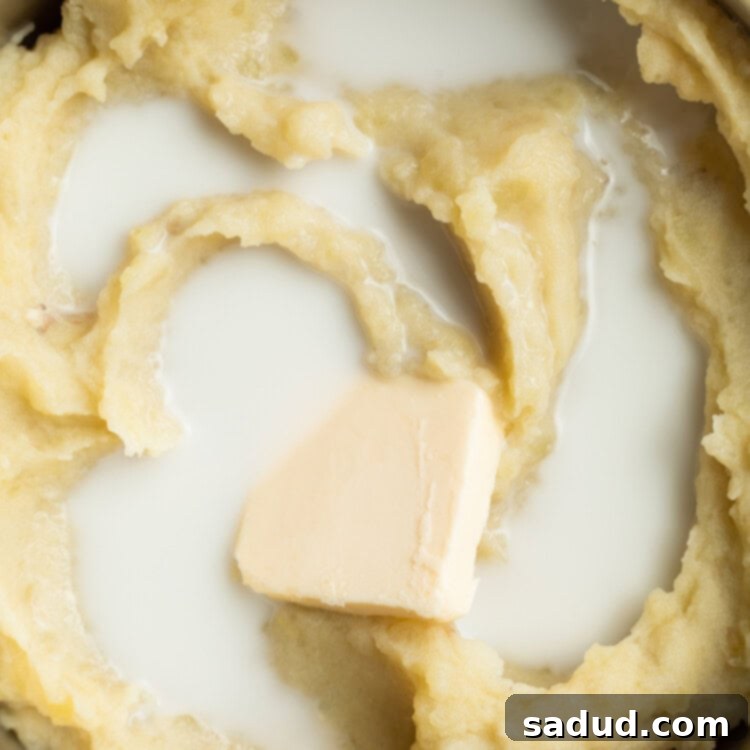
How to Reheat Mashed Potatoes
 Cheryl Malik
Cheryl Malik
Print
SaveSaved!
Ingredients
- 4 cups mashed potatoes
In the microwave:
- butter as needed
- milk as needed
In the oven:
- ½ cup milk
- 3 tablespoons butter
One the stove:
- ½ cup milk
- 1 tablespoon butter
Equipment
-
Microwave-safe bowl
-
9×13 baking dish
-
medium pot
Instructions
In the microwave:
-
Place mashed potatoes in the microwave and reheat at half power for 5 minutes.

-
Remove potatoes, give them a quick stir, then mix in additional butter and milk as needed.
In the oven:
-
Preheat oven to 350° Fahrenheit and transfer potatoes to a baking dish.

-
Pour milk and disperse butter over potatoes then cover with foil and bake for 25-30 minutes or until warm throughout.

On the stove:
-
Add mashed potatoes, milk, and butter to a large saucepan over low heat.

-
Stir every minute until warm throughout, should take about 8-10 minutes.
Notes
- Each method is based off of using 4 cups of mashed potatoes, though adjust amounts depending on how much mashed potatoes you’re looking to reheat.
Recipe yields approximately 6 servings. Actual number of servings will depend on your preferred portion sizes.
Nutritional values shown are general guidelines and reflect information for 1 serving of reheated mashed potatoes in the oven. Actual macros may vary slightly depending on specific brands and types of ingredients used.
To determine the weight of one serving, prepare the recipe as instructed. Weigh the finished recipe, then divide the weight of the finished recipe (not including the weight of the container the food is in) by 6. Result will be the weight of one serving.
Nutrition Information
Number of total servings shown is approximate. Actual number of servings will depend on your preferred portion sizes.
Nutritional values shown are general guidelines and reflect information for 1 serving using the ingredients listed, not including any optional ingredients. Actual macros may vary slightly depending on specific brands and types of ingredients used.
To determine the weight of one serving, prepare the recipe as instructed. Weigh the finished recipe, then divide the weight of the finished recipe (not including the weight of the container the food is in) by the desired number of servings. Result will be the weight of one serving.
